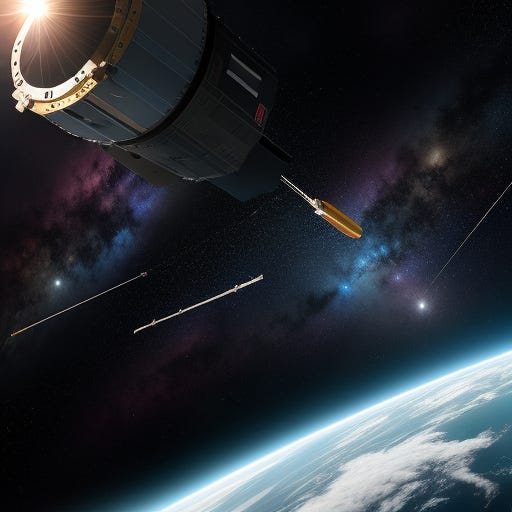Precision in the Void: The Intricacies of Communicating with Voyager Spacecraft
Precision and Accurate Engineering — Space Communication

Precision and Accurate Engineering — Space Communication
Voyager 1 and Voyager 2 spacecraft launched in 1977 are at the moment the farthest man-made objects in space (from Earth). At the time of writing this article (11th June 2023), Voyager 1 is 23,832,997,181 Km from Earth whereas Voyager 2 is 19,881,531,586 Km from Earth. To put it into perspective, you can go to Pluto, come back, and go back again and the distance traveled by you will be still lower than the distance to Voyager 2. In spite of the distance, these space crafts are still communicable (WAY beyond their planned mission may I add) even though it takes us 46 hr to send a signal and receive the signal back from the spacecraft (assuming everything goes well, else we won’t even know if there is any problem for the next 46 hr, then it’s debugging and run again). These long-distance calls are operated by NASA Deep Space Network Telescope located around the Earth.
Let’s take a walk through the precision and accuracy it takes to communicate with these objects.

Orientation and Direction
Visualize pointing a laser pointer at a distance of 10m, now if you’re off by one degree, the point will be off by 0.17m from the target. Scale this up to 1km, you’ll be off by 17m. Scale this off to 20 billion km, and you’re off by 349,101,298 km.
Now thankfully communication with Voyager doesn’t work like a laser pointer, instead, it works like a narrow beam flashlight, still, the precision required to communicate with Voyager is around 130 arcseconds i.e. 0.036 degrees. (Note: Answer produced by GPT4 and Wolfram Alpha, might be factually incorrect — https://chat.openai.com/share/f6daa166-5888-44e9-82fe-1629ba68906c/).
This accuracy needs to encapsulate the results of everything including the accuracy of manufactured mechanical components, sensors, control electronics, and software systems, and even needs to compensate for vibrations in the ground due to the passing of vehicles or earthquakes.
On the other side, the orientation also needs to be matched by Voyager autonomously, which means it needs to look at known stars and calculate and orient itself so that its antenna is always pointing at Earth. Else, we won’t even be able to command it to point to Earth if we lose communication.
Amplification
Even after highly precise orientation, the signals received by these antennas are very faint. High gain amplification is required to gather something meaningful out of this interaction.
Noise Rejection
When we do amplification, along with symbols the other thing that gets amplified is the noise. The sources of noise could be many, apart from natural sources, the instrument capturing and amplifying the signal themselves produces noise. One clever engineering technique in order to reduce instrument noise is to operate the instruments at extremely cold temperatures. How cold? Around 255 degrees Celcius below zero or 18 degree Kelvin. That way, we minimize thermal noise.
Another way is to use clever filtering techniques to remove the randomness of data.
Yet another is to use encoding techniques so that we increase Signal to Noise Ratio. Sometimes we even trade off Symbol Signal to Noise Ratio for Bit Signal to Noise Ratio.
Astronomically Precise Calculations
None of the above matters if we are not able to precisely locate the Voyager WRT Earth in the first place. That involves a whole lot of Math and Physics, to begin with. The trajectory of the spacecraft not only depends on the fuel it burns and thrusts it produces, but also on the effect of gravitation of the nearby and farther-off objects. Not only that but also the effect of incalculable solar winds. Also the changing position of the telescope due to rotation and revolution of Earth.
Being launched in the 1970s also means that most of the calculations were done by hand and mechanical or huge electrical calculators introduced manual and technical sources of errors.
Even with modern computers, if you use the incorrect tools, the results are dramatic e.g. in regular programming language 0.1 + 0.2 is not equal to 0.3 So if we are not aware of the underlying abstractions, results can be catastrophic.

Weather
While some of the above parameters are in our control, the weather is truly not. Forecasting, compensating, and accepting the effects of weather is all we can do.
Cloud coverage results in losing the strength of the signal being received. Rain and snow result in signals being refracted. Sunny day results in higher noise in electronics. Lightning produces signals and noise which might have been unanticipated. Earthquakes and ground vibrations result in calibration and compensation being required for orientation.
There will be times when for days we just won’t be able to communicate with the probes for days.
Technological Downtimes and Maintainance
These spacecraft were manufactured and launched in the 1970s. Imagine creating something with the technology available 50 years in the past with no way of upgrading it since it is launched. Not only that, most of the ground systems hardware and software needs to be frozen in that era. All components needed for upgrades for all the planned mission time and beyond the need to be planned for the supply chain and well-documented for the manufacturing process.
Moreover, any maintenance for ground equipment means no communication with a probe for that amount of time. Sometimes it can be months. Any firmware update over the air also means if something goes wrong, there is no way to reset it.
Conclusion
The efforts that go into precise study fields are beyond comprehension. Scientist spends years and decades studying and calculating variables for such missions. Engineers spend the same amount of time finding clever solutions to realize those calculations and convert them to something achievable. Manufacturing team on finding solutions to create components with a small level of tolerance for failures. Test teams on finding and simulating infinite possible variables that could deter the mission. Even after that, a simple components failure let it be as simple as a capacitor or screw or scratch can result in a catastrophic mission failure for all the time and resources being put into the missions. A simple math error, human or calculator, or theoretical error can result in the same error. As disheartening as the mission failure could be, they don’t mean effort failure. These learnings are constantly incorporated for future missions. Processes are streamlined and we build and stand on top of giants for the next missions. Onwards and upwards.
Note: Precision and Accuracy are not the same

Credit where it is due
- AWESOME video discussing all the factors discussed above in detail and with visible enthusiasm by Dave of channel EEVblog with Richard Stephenson from Deep Space Network, NASA.
2. Awesome website for tracking live space objects
TheSkyLive - Your Guide to the Solar System and the Night Sky
This interactive 3D view shows the current positions of the major bodies of the Solar System and the brightest comets…theskylive.com
3. Website for calculating deep math questions
Post Script
This is the first article in the series I’m planning to discuss similar challenges in other precise engineering fields like Electronics, Semiconductors, Space, Computer Science, and Quantum Physics.
Some of the planned articles include Relativistic Timekeeping of GPS, LIGO, Semiconductor Fabrication, Electronics Design and Testing.
Would love to chat about similar topics if someone is interested in one on one discussion on the same.
